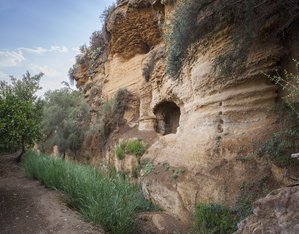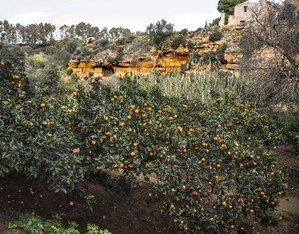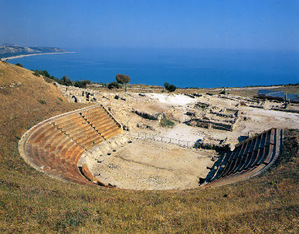 Warning
Warning
Due to the current health emergency situation visiting times and arrangements may be subject to change. It is therefore advisable to check these by contacting the garden directly.
A “small valley that, because of its surprising fertility, resembles the Valley of Eden”; this is how at the end of the 18th century the abbot of Saint-Non described this corner of the world that today has been transformed into a botanical garden in which the landscape of the Valley of Temples merges with the Mediterranean scrub and citrus groves.
In the 5th century BCE, the city of Acragas, the ancient Agrigento, had reached its highpoint in terms of splendour and power and its tyrant Theron, to satisfy the need for a water supply for the about 200,000 inhabitants, started the construction of a great water supply system by digging underground chambers from which water flowed for irrigation and the construction of the great Kolymbethra basin, near the western spur of the Valle dei Templi hill. In the 1st century BCE the location had already been abandoned and it was only from the 12th century that it was once again used for the cultivation of sugar cane, and later citrus fruits, becoming a perfumed garden attracting many travellers on their Grand Tour. In 1999, after a long period of neglect, the area was entrusted to FAI, Fondo Ambiente Italiano, Italy’s National Trust, by the Region of Sicily. A thorough restoration was carried out re-establishing its original value, salvaging all the remains of rural architecture (dry stone walls, terraces, “gebbie” cisterns and the “saje” Arab irrigation system). The hillsides are covered with typical Mediterranean vegetation with myrtle bushes, mastic trees, turpentine trees, phillyrea, spurge and broom. In the areas that are not irrigated, mulberries, carob trees, prickly pears, almonds and enormous Saracen olive trees grow; rock vegetation with Mediterranean dwarf palm, osyris and caper bushes thrive. On the valley plain, as well as the stream lined with hydrophilic plants, such as giant canes or castor beans, and willows and silver poplar, the citrus grove spreads out and is irrigated using traditional Arab techniques.
Highlights

The ancient hypogea
The “Feaci Aquaducts”, named after the architect Feace who designed them, date back to the 5th century BCE. These underground chambers can be visited embarking on a 185-meter underground itinerary wearing safety helmets and head torches.

Botanical itinerary
The itinerary across the garden takes visitors to its various areas: the citrus and almond-olive groves, another area with typical Mediterranean scrub plants; an area with riparian vegetation, hydrophilic plants (giant cane, castor bean, etc.); and lastly an area with rock vegetation with Mediterranean dwarf palms, osyris and caper bushes.

An area of great riches
Besides the nearby “Valley of Temples”, a UNESCO World Heritage Site, around Kolymbethra there are many other archaeological sites that are worth a visit: the tombs in Sant'Angelo Muxaro, the ancient Eraclea Minoa, the Thermal Baths of Sciacca, and the Greco-Punic settlement at Adranon.
 Giardino della Kolymbethra – FAI
Contacts
Giardino della Kolymbethra – FAI
Contacts
Contacts
Telephone:+39 335 1229042
Address
Viale Caduti di Marzabotto
92100, Agrigento (AG)

FAI - Fondo Ambiente Italiano
 Giardino della Kolymbethra – FAI
Opening times and prices
Giardino della Kolymbethra – FAI
Opening times and prices
Pricing
Entrance to the Valley of the Temples and Kolymbethra Garden
The ticket allows the entrance to the Valley of the Temples Park, the Garden of Kolymbethra and the Temple of Vulcan.
- FAI members: € 12
- Full price: € 17
- Reduced (6-17 years): € 0
- Children up to 5 years of age: free admission
- Reduced for EU citizens/students (18-26 years old): € 11
Entrance to the Kolymbethra Garden only
The entrance to the Garden of Kolymbethra, subject to the entrance to the Valley of the Temples, can be purchased at the ticket office of the Garden.
- FAI members: free entry (with the exception of specific events in which only the supplement to the event will be requested)
- Full price: € 6
- Reduced (6-18 years): € 2
- Children up to 5 years of age: free admission (except for specific events where only a supplement will be requested)
- Students up to 25 years: € 4
- Residents of the Municipality of Agrigento: € 4
- National Trust members, Bienfaiteurs Amis du Louvre members, disabled people and accompanying person: free entry
- Families (2 adults and children 6-18 years old): € 13
- Groups: discounted rates for a minimum of 20 participants (upon completion of the request and quote from the
form
of FAI)
Ipogei route supplement
In addition to the visit of the Garden it is possible to integrate the visit with a tour lasting one hour in small groups of 8 / 10 people that includes: the introduction to the Garden of Kolymbethra and the system of hypogea, preparation and equipment, the path of about 20 minutes inside the hypogeum with the staff of the Association Agrigento Sotterranea.
The supplement is to be added to the price of the entrance ticket to the Valley and/or Garden. (Due to the Covid emergency, the Hypogeum route cannot be visited for the time being.)
- Full price: € 10
- Reduced (6-14 years): € 9
- Children (0-5 years): free (must be accompanied by an adult)
 Giardino della Kolymbethra – FAI
How to get there
Giardino della Kolymbethra – FAI
How to get there
Address
Viale Caduti di Marzabotto
92100, Agrigento (AG)
Latitude: 37.288728
Longitude: 13.582917
How to arrive by road
From Agrigento follow the signs for the Valley of the Temples.
How to arrive by train
From Palermo or Caltanissetta arrive at Agrigento Centrale train station, then continue by bus to the Valley of the Temples.
How to arrive by bus
Take the bus from Agrigento Centrale train station.
Additional directions
The entrance to the Garden of Kolymbethra can be reached at the Valle dei Templi-Tempio di Giunone ticket office.
 Giardino della Kolymbethra – FAI
Services/Accessibility
Giardino della Kolymbethra – FAI
Services/Accessibility
Services
Inside the Kolymbethra Garden there is the FAI Fondo Ambiente Italiano bookshop.
The Garden has a picnic area, surrounded by fragrant citrus trees. It is possible to eat your own packed lunch with a contribution of €2 per person (groups or individuals) at the following times: 12:15, 13:15, 14:15. The contribution is a small support to the costs of maintenance and waste disposal of the area. To book write to [email protected] .
The Garden has a picnic area, surrounded by fragrant citrus trees. It is possible to eat your own packed lunch with a contribution of €2 per person (groups or individuals) at the following times: 12:15, 13:15, 14:15. The contribution is a small support to the costs of maintenance and waste disposal of the area. To book write to [email protected] .
The Garden has a picnic area, surrounded by fragrant citrus trees. It is possible to eat your own packed lunch with a contribution of €2 per person (groups or individuals) at the following times: 12:15, 13:15, 14:15. The contribution is a small support to the costs of maintenance and waste disposal of the area. To book write to [email protected] .
The Garden has a picnic area, surrounded by fragrant citrus trees. It is possible to eat your own packed lunch with a contribution of €2 per person (groups or individuals) at the following times: 12:15, 13:15, 14:15. The contribution is a small support to the costs of maintenance and waste disposal of the area. To book write to [email protected] .
- Guided tours: guided tours for groups (maximum 50 people) in Italian and in foreign languages (English, French, German and Spanish) are available by appointment at a cost of € 50.00. For information and reservations consult the following form
- Visits for schools: guided tours are available for school groups. For further information please visit Fai Scuola
Comfortable shoes are recommended.
Comfortable clothes and closed-toe shoes are recommended for the visit to the Hypogea.
Accessibility
The paths of the Garden are in beaten earth, but allow the transit of wheelchairs allowing therefore a partial visit (flat bottom of the garden).
Persons with disabilities must always be accompanied by their attendant.
The visit can be made only by telephone reservation at 335-1229042, to arrange access from the north entrance of the Garden of Kolymbethra.
Because of the difficulties in visiting the Hypogea, people with walking difficulties are advised to contact the Garden for more information.
 Giardino della Kolymbethra – FAI
Private events
Giardino della Kolymbethra – FAI
Private events
The Garden of Kolymbethra offers its spaces for photographic and filming.
The Garden of Kolymbethra allows the organization of corporate events such as team building activities and special visits in the hypogea equipped with helmets with integrated flashlights and accompanied by experienced cavers.
For information:
Phone: 3351229042
Email: [email protected]
 Giardino della Kolymbethra – FAI
Itineraries
Giardino della Kolymbethra – FAI
Itineraries
You could find the garden in these itineraries
 Favorite saving result
Favorite saving result
 Warning!
Warning!
You've have to sign up or sign in to add this element to your favorites.
